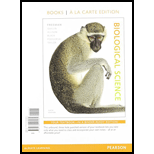
Concept explainers
Which of the following occurs when a covalent bond forms?
a. Electrons in valence shells are transferred from one atom to another.
b. Electrons in valence shells are shared between atoms.
c. Partial charges on polar molecules interact.
d. Nonpolar molecules are pushed together by surrounding water molecules.
Introduction:
Covalent bonds are formed by sharing of the electron pairs between atoms. These electron pairs are referred to as shared pairs or bonding pairs. The chemical bond in which the complete transfer of electron present in the outer shell takes place is known as an ionic bond.
Answer to Problem 1TYK
Correct answer:
Electrons in valence shells are shared between atoms.
Explanation of Solution
Explanation/Justification for the correct answer:
Option (b) is given that the bond is formed by the electron sharing. Covalent bonding occurs when pairs of electrons are shared between atoms. Atoms are covalently bond with other atoms by forming a full electron shell providing more stability. By sharing their outer most (valence) electrons, atoms can fill up their outer electron shell and gain stability. Hence, option (b) is correct.
Explanation for incorrect answers:
Option (a) is given that the valence shells are transferred. The chemical bond, in which the complete transfer of electron present in the outer shell occurs is known as an ionic bond. So, it is incorrect answer.
Option (c) The polar molecules have partial charges present on them, the interaction of the two-partial charged atoms results in the formation of the dipole-dipole interaction. It takes place when two molecules carry opposite partial charge. So, it is incorrect answer.
Option (d) The interaction between the water and the non-polar molecule, in which the non-polar molecules attract themselves is known as hydrophobic interaction. These molecules do not form bonding with the water molecules, as a result, they are forced to interact among themselves. So, it is incorrect answer.
Hence, options (a), (c) and (d) are incorrect.
Covalent bonds are formed when electrons are shared between atoms.
Want to see more full solutions like this?
Chapter 2 Solutions
Biological Science, Books a la Carte Plus Mastering Biology with Pearson eText -- Access Card Package (6th Edition)
- 18. Watch this short youtube video about SARS CoV-2 replication. SARS-CoV-2 Life Cycle (Summer 2020) - YouTube.19. What is the name of the receptor that SARS CoV-2 uses to enter cells? Which human cells express this receptor? 20. Name a few of the proteins that the SARS CoV-2 mRNA codes for. 21. What is the role of the golgi apparatus related to SARS CoV-2arrow_forwardState the five functions of Globular Proteins, and give an example of a protein for each function.arrow_forwardDiagram of check cell under low power and high powerarrow_forward
- a couple in which the father has the a blood type and the mother has the o blood type produce an offspring with the o blood type, how does this happen? how could two functionally O parents produce an offspring that has the a blood type?arrow_forwardWhat is the opening indicated by the pointer? (leaf x.s.) stomate guard cell lenticel intercellular space none of thesearrow_forwardIdentify the indicated tissue? (stem x.s.) parenchyma collenchyma sclerenchyma ○ xylem ○ phloem none of thesearrow_forward
- Where did this structure originate from? (Salix branch root) epidermis cortex endodermis pericycle vascular cylinderarrow_forwardIdentify the indicated tissue. (Tilia stem x.s.) parenchyma collenchyma sclerenchyma xylem phloem none of thesearrow_forwardIdentify the indicated structure. (Cucurbita stem l.s.) pit lenticel stomate tendril none of thesearrow_forward
- Identify the specific cell? (Zebrina leaf peel) vessel element sieve element companion cell tracheid guard cell subsidiary cell none of thesearrow_forwardWhat type of cells flank the opening on either side? (leaf x.s.) vessel elements sieve elements companion cells tracheids guard cells none of thesearrow_forwardWhat specific cell is indicated. (Cucurbita stem I.s.) vessel element sieve element O companion cell tracheid guard cell none of thesearrow_forward
 Human Biology (MindTap Course List)BiologyISBN:9781305112100Author:Cecie Starr, Beverly McMillanPublisher:Cengage Learning
Human Biology (MindTap Course List)BiologyISBN:9781305112100Author:Cecie Starr, Beverly McMillanPublisher:Cengage Learning
 Concepts of BiologyBiologyISBN:9781938168116Author:Samantha Fowler, Rebecca Roush, James WisePublisher:OpenStax College
Concepts of BiologyBiologyISBN:9781938168116Author:Samantha Fowler, Rebecca Roush, James WisePublisher:OpenStax College Biology Today and Tomorrow without Physiology (Mi...BiologyISBN:9781305117396Author:Cecie Starr, Christine Evers, Lisa StarrPublisher:Cengage Learning
Biology Today and Tomorrow without Physiology (Mi...BiologyISBN:9781305117396Author:Cecie Starr, Christine Evers, Lisa StarrPublisher:Cengage Learning Biology (MindTap Course List)BiologyISBN:9781337392938Author:Eldra Solomon, Charles Martin, Diana W. Martin, Linda R. BergPublisher:Cengage Learning
Biology (MindTap Course List)BiologyISBN:9781337392938Author:Eldra Solomon, Charles Martin, Diana W. Martin, Linda R. BergPublisher:Cengage Learning





